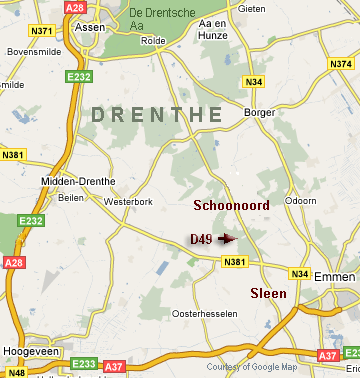 he name “Priestless Church” (Low Saxon Papeloze karke, Dutch Papeloze kerk)
he name “Priestless Church” (Low Saxon Papeloze karke, Dutch Papeloze kerk)  is that of a dolmen situated in a wooded area between Schoonoord and Sleen (municipality of Coevorden)
in the lovely Netherlands province of Drenthe. Its index number is D49. It
appears to have been constructed at the time of the Funnelbeaker Culture which arose in Europe around four millennia before Christ.
is that of a dolmen situated in a wooded area between Schoonoord and Sleen (municipality of Coevorden)
in the lovely Netherlands province of Drenthe. Its index number is D49. It
appears to have been constructed at the time of the Funnelbeaker Culture which arose in Europe around four millennia before Christ.
The name “Priestless Church” refers to clandestine
religious services conducted locally in the open air, typically in wooded
areas, under the leadership of Menso Alting during the 16th-century persecution
of Protestants. Such services came to be referred to as “priestless” (using
the derogatory word pape or paap for “Roman Catholic priest,” which originally meant “pope”). In the words of Calvin, this was une église sans pape (a church without pope). The name of the dolmen is meant to commemorate one
or more such open-air services of the Eighty Years’ War (which is also known as the Dutch Revolt).
Such open-air services are still being conducted once a year. The last one took
place recently, on July 22. The previous one was held entirely in Drenthe
Low Saxon and was organized by the historical association of Hoogeveen whose
name is Die Luyden van ’t Hooge Veene (archaic Low Saxon for “The People
of the High Fen”).
The dolmen is now surrounded by forest, but in the 16th century it lay exposed
out on the open Ellertsveld. Uninvited guests could be seen approaching from
afar, and for safety’s sake a patrolman would stand guard during a service.
Because of its then very poor condition,
the dolmen was restored in 1959 under the direction of archeologist Albert
van Giffen.
 Other
pages:
Other
pages:
• Gemeinde
Coevorden
• De
Papeloze kerk (Dutch, 1)
• De
Papeloze kerk (Dutch, 2)
• Coevorden
Municipality
• Province
of
Drenthe (PDF)
• Dolmens
(Wikipedia)
• The
Official Dolmen Center
• Dolmens
in the Netherlands
• Arend
Victorie’s introduction (1)
• Arend
Victorie’s introduction (2)

